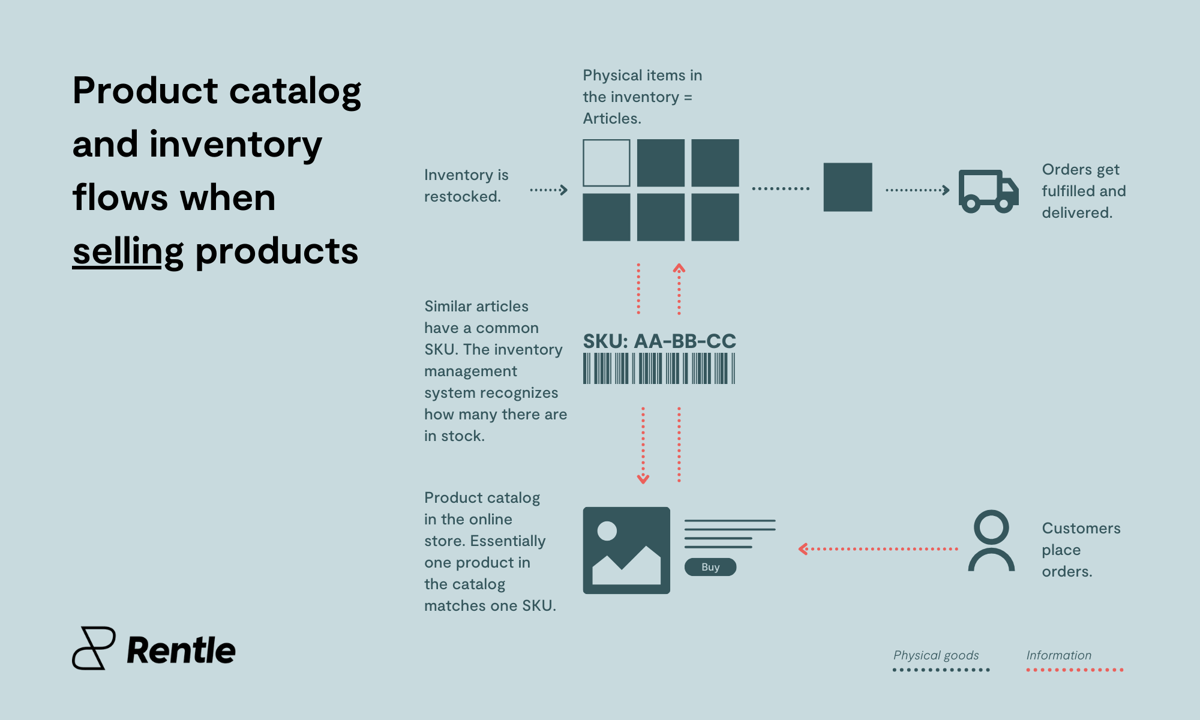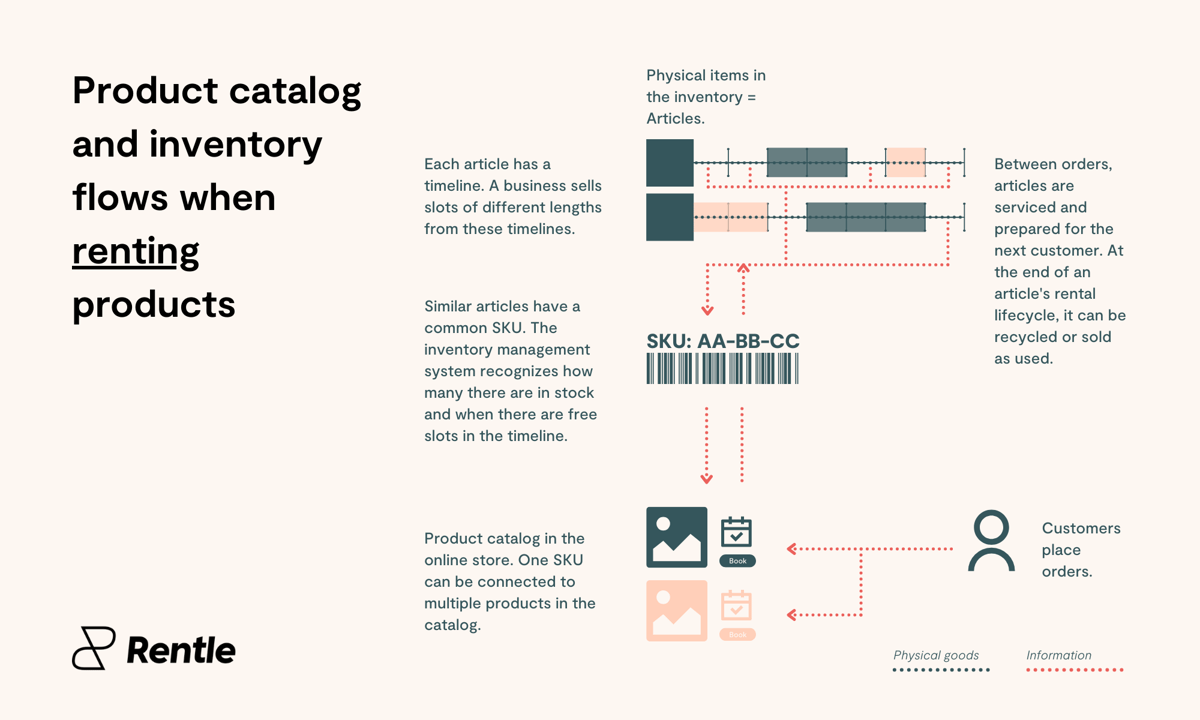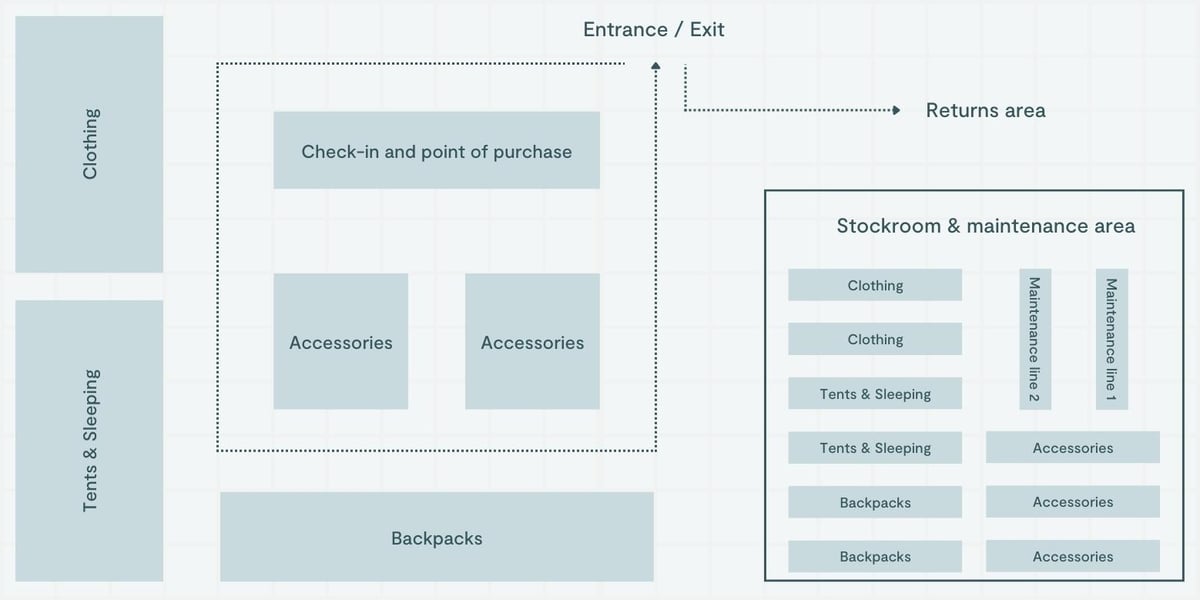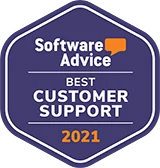Inventory management is hands down one of the most essential operational processes of a rental business. It's a process that has a high impact on both sales and costs – after all, it's about managing and keeping good care of the most critical assets of your business.
There's a lot to chew and take into account, but with the right tools and processes, your company is set for success. No matter what equipment you're renting, by reading this article, you'll learn about the basic principles of preparing, managing, reporting, and optimizing your rental inventory.
What is inventory management, and how is it different for a rental business?
Inventory refers to all the physical assets your company owns and uses as a trading instrument, for example, by selling or renting them out. Every item in your warehouse or retail store's backroom is part your the inventory. Rental inventory management is the process of sourcing, storing, tracking, scheduling, maintaining, and recycling your equipment as effectively as possible.
The two-way – or circular – flow of goods changes the nature of inventory management compared to selling stuff. When selling products, the expectation is that the seller won't see the sold products again. The direction of goods is one-way, and the focus is on optimizing the cycle from sourcing to sale.

Whereas for rental companies, it is vital to ensure the products get back in stock at the agreed time so they can be serviced and prepared for the next customer. While it is also important for rental companies to source products effectively, the main emphasis is tracking and scheduling the rental assets and ensuring enough stock is available at the right place and time.

The difference between product catalog and inventory
Another difference between renting and selling lies in the inventory and product catalog correspondence. On a conceptual level, it is important to understand that these are not the same in the rental industry.
The articles and Stock Keeping Units (SKUs) represent your business's physical assets in the inventory. Whereas your product catalog is the way you commercialize these assets. It can include rentals of different durations, combinations of rentals and services, and insurances, for example.
For example, an outdoor rental shop might sell guided tours in addition to basic gear rentals. Even though the guided tour and the standard rentals might utilize the same physical assets from the inventory, they are different products in the catalog with their unique value props and price.
Rental companies don't sell physical items. Instead, they sell time for the right to use these physical items. Whereas for a company that sells t-shirts, a white t-shirt is a white t-shirt both in the inventory and in the product catalog.
So, it's not about maximizing the unit sales when discussing rental inventory management and growing sales. It's about maximizing the usage of individual rental assets and fitting in as many bookings as possible on the booking calendar. Pretty much like playing Tetris with your calendar.
Preparing your inventory
Inventory can be a rental company's most expensive asset, requiring upfront investments before any sales. Whether you use your savings or finance the rental equipment by taking a loan from a bank, you want to be sure that you're using the money wisely. Next, we'll cover how to plan and prepare your inventory.
Define the size of your inventory
So, you have your business idea and probably thought out how everything will work. However, you need to make sales and cost estimates to ensure your business idea is viable in real life. These estimates will give you an idea of financial projections and how much you have to invest in equipment to reach your estimates.
Typically companies approach forecasts through sales targets which determine how much to invest in equipment, marketing, and other things. Another approach would be to determine the number of items you purchase and calculate how much revenue you can make with the planned fleet size.
Learn how to choose the right products →
Storing and warehousing
Before purchasing any equipment, you must plan how and where you store them. The most common and straightforward way, especially for small businesses, is to have their warehouse connected to the shop. That's when your company has a brick-and-mortar presence.
When evaluating potential store premises, one critical checkbox is whether it has enough floor space for sales and stockroom. Once you have different alternatives on the table, the first step is to map out the layouts and plan how the spaces will work in practice. A good space for a rental business allows for smooth people and product flows for pick-ups and returns.
A good practice is splitting your sales space and stockroom into sections by product type. For example, an outdoor store can have its store layout categorized into sections, so that clothing, sleeping gear, backpacks, accessories, etc. have dedicated departments. Furthermore, an outdoor store that's also renting gear should dedicate an area for returns. The dedicated returns area significantly speeds up the customer flows and adds more clarity to your return process.
Similarly, the stockroom should have dedicated sections and shelves for each category. This makes it easier for your staff to find the right products, replenish shelves and count inventory when the time comes.

A simple example of how a rectangular store space could work for an outdoor store.
Group and categorize your products
As described above, categories help you organize, replenish, and count stock at your physical premises. Additionally, logically and systematically categorizing your products and SKUs helps keep your data organized and control and optimize your inventory more effectively.
The methods for grouping assets can differ from company to company. Some merchants may prefer to organize SKUs by brand, some by product type, or some other characteristic that makes sense. The most important thing, however, is that you and your staff are comfortable with the system.
Build a list of equipment on a spreadsheet
Once you have determined what and how many products you need to start or expand your business profitably, you should build a spreadsheet list of the equipment you're acquiring. Even if you're planning to use inventory management software, this step is recommended as it works as a backup and speeds up the setup process.
List each item on its row and use the columns to add product information such as manufacturer, model, article ID, SKU, and any custom fields for other specifications you'd like to document.
If you're using Twice for inventory management, here are the instructions on how to format data on a spreadsheet to work with file imports.
Set up your equipment rental software
Do yourself a favor and start using equipment rental software from the get-go. An automated rental system not only helps you manage inventory more effectively but also connects the dots between product catalog, sales channels, and operational aspects of the business.
Rental management software is the enabler of many actions discussed in this article. While pen and paper or a spreadsheet might do just fine initially, you will eventually need a more sophisticated – and in particular automated – inventory management system as your business grows.
If you worry about the cost of such a system, Twice has a free version that's like a spreadsheet on steroids, plus it has a connected order management system, payment processing, an online booking system, and other cool features.
Tracking and maintaining your inventory
Effective inventory management is one of the most crucial areas of a rental business. By overlooking its importance, you risk losing sales or overinvesting in the equipment leading to increased costs. In this chapter, we'll share tips on improving the efficiency and accuracy of your inventory tracking process and ensuring your assets stay well maintained.
Automate your inventory control
Inventory control is the task of managing your existing stock and being aware of how much you have available products at each time, where they are, and in what condition. Efficient inventory control decreases your inventory costs and ensures smooth order fulfillment, especially if you have many walk-in customers while accepting online bookings simultaneously.
An automated inventory tracking system makes inventory control easier. A small business might cope with a pen-and-paper method or a spreadsheet template, but as the business grows, a proper inventory tracking system is essential to keep your business up with the growth.
Automating your inventory control procedures with inventory management software and other combined tools allows you to see real-time inventory information, forecast demand, prevent stockouts, and save hours on manual work.
Set up a scanner system
Setting up an inventory scanner system is the best way to speed up and ensure accurate inventory tracking. Twice and other equipment rental software typically support barcode scanners out of the box. A scanner system helps you automate tasks and reduce human error at every step of the inventory management process.
To start with an inventory scanning system, you need to define unique product IDs for each item you want to track individually. You can store product ID information in a barcode and attach printed barcode labels on the items so that they match the IDs defined in your rental software.
Once the barcode labels are in place and connected with the software, you're ready to start scanning. With wireless scanners, you can move around your store or warehouse and perform tasks wherever it's the most convenient, whether fulfilling orders or handling returns.
Schedule product maintenance
Rental products require regular maintenance between usage and during their life cycles. The level of needed care varies between different products, but every product requires some – whether it's basic cleaning or more throughout inspection.
To ensure you have time to take care of your items between bookings, you want your rental inventory management software to automatically reserve time for equipment maintenance before and after the bookings. To plan more in-depth periodic product maintenance, you need to keep track of your products' usage and maintenance history. Try to schedule more extensive product maintenance outside the busiest periods.
Analyzing and optimizing your inventory
If you're looking to streamline your rental inventory and raise profit margins, you must dedicate time to analyzing and optimizing your inventory.
Inventory optimization is the process of maintaining optimal stock levels to meet demand, controlling costs, and avoiding common problems related to inventory, such as inventory shortages, overstocking, and renting defective products to customers. Optimizing your inventory helps reduce operational costs, boost customer satisfaction, fulfill orders faster, and maintain optimal stock levels.
Below we'll walk you through some of the essential techniques and best practices you can implement in your rental management operations.
Forecast demand
Forecasting demand helps you find the right balance between customer satisfaction, revenues, and costs. Demand forecasting is vital for every rental business. Still, it is particularly critical for seasonal businesses that must forge when the iron is hot and optimize costs during the off-season.
Following the right inventory metrics helps you identify recurring patterns over time. For example, do you notice months when you lose sales because all your products are reserved? A high stockout rate signals too low inventory levels, inefficient maintenance processes, or sub-optimal scheduling, which independently or together lead to lost sales. Prepare for demand peaks by adding more items to your fleet or improving your maintenance and order management processes.
On the other hand, there's no point holding on to any more extensive inventory than needed. When the demand is slowing down, it is time to reduce stocks. For example, you could organize a second-hand sale of refurbished rental equipment or appropriately recycle the products. To recognize the right moment to start reducing stocks, keep an eye on your equipment's time utilization rate. When the ratio approaches the lower limit of the accepted level, it is time to prepare to reduce the stock.
Recognize your most profitable products
Knowing your most popular and profitable products and categories is essential for intelligent decision-making. While most rental businesses need to carry also low-profit (usually supplementary) items in the inventory to cater to customer needs, it's essential to know which products raise the bottom line.
As rental companies don't need to purchase new stock as regularly as retailers, the traditional ABC analysis is not the most applicable method to analyze the value of your assets for your business. Instead, rental businesses should look at products generating most of their revenue and focus on avoiding stockouts and optimizing utilization rates.
Perform periodic inventory audits
An inventory audit is a process of checking a company's inventory levels against its financial records. Well-documented and managed inventory is easier to audit and can significantly cut down an audit's frequency, length, and cost.
Audits are always laborious endeavors but are all the more important. Since inventory is the most valuable asset of a rental company, the importance of periodic inventory audits shouldn't be overlooked. Rental businesses should perform inventory audits for accounting purposes but also multiple other reasons.
-
Verify your inventory value
Inventory audits can help rental businesses to verify the items in possession, lost or damaged. The count allows to write down lost products and products that have been definitively discarded, conduct depreciations according to plan, and calculate the total value of the inventory.
-
Budget for new acquisitions
If you don't know what equipment you possess and in what condition they are, you can't budget for the next batch of inventory you need to purchase – an inventory audit helps you identify the need for new gear.
-
Optimize your fleet
Audits work as the basis for healthy inventory management. As written above, it is essential to be able to forecast demand and recognize your most profitable products. Without knowing what you have, you can't identify SKUs that are not performing or vice versa, performing better than expected.
Another important aspect you should consider in the rental industry is the durability of the products. The longer a product can circulate as a productive asset and the easier it is to maintain, the better. Inventory audits help you eliminate unsuccessful products and double down on gear that's working.
Fleet optimization is essential because carrying unused or low-quality inventory ties up capital that could be used more effectively. The holding costs of stock include, e.g., financing, warehousing, labor, maintenance, insurance, and other expenses related to holding inventory.
Start building supplier relationships
While rental businesses don't have as frequent reorder cycles as manufacturers and retailers, building close relationships with trusted suppliers is still valuable. Good relationships with suppliers can unlock better deals, increase reliability, provide insights into emerging trends, and give you early access to new product lines.
Summary
Inventory management is one of those things you need to tweak and keep an eye on continuously.
The key takeaway from this article is to understand that inventory management touches nearly every area of a rental business, and there are countless means to source, store, and sell products better.
By focusing on honing your rental inventory management processes, you're focusing on customer satisfaction, operational efficiency, and maximizing sales – quite essential topics for a successful business.










